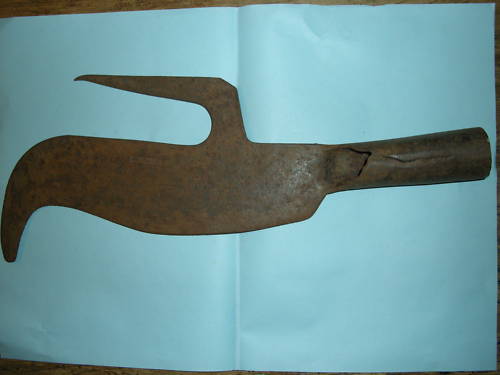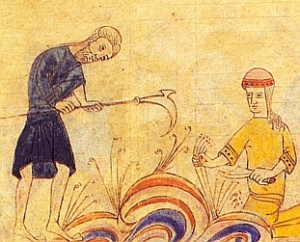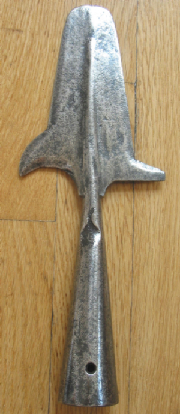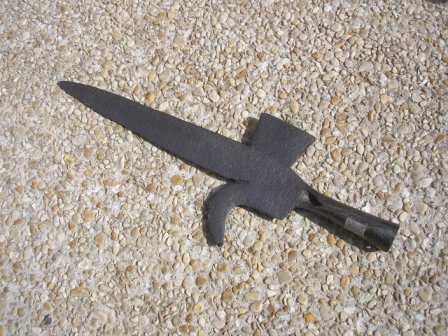Wikipedia mentions it was in use during the 14th century, though I can't find anything more specific.
Does anyone know of the oldest depiction or referance to a bill is?
Well, if I' not mistaken the Billhook has its origins in an old English farming implement. That probably means that it may have served as an ad hoc weapon (from its days as a said farming implement) for a considerable time before being developed into a polearm.
I honestly don't know when the billhook as we would know it became common on the battlefield, but if I was to guess I would say sometime during the 13th century. I can't recall there ever being a reference to them during the 12th centruy or prior, and so if they are known to have been in widespread use during the 14th, the 13th century would serve as a decent educated guess.
Hope this helps.
Cheers,
Tormod
I honestly don't know when the billhook as we would know it became common on the battlefield, but if I was to guess I would say sometime during the 13th century. I can't recall there ever being a reference to them during the 12th centruy or prior, and so if they are known to have been in widespread use during the 14th, the 13th century would serve as a decent educated guess.
Hope this helps.
Cheers,
Tormod
See http://www.myArmoury.com/talk/viewtopic.php?p=223022#223022
The billhook has been in use in Europe for over 2000 years - it predates the Roman invasion of Britain.... Its use as a weapon almost certainly has an equally long history. It was most likely the ancestor of the fighting bill, a pole arm closely allied to the vousge, halberdm guisarme, pike etc....
Peasant soldiers, bound to fight for their feudal lord, almost certainly provided their own weapons, the lord of the manor only supplying those for his own personal castle guard... The one edged tool almost all such peasants would have owned would have been a billhook (just called a bill before the 1800's)....
 Attachment: 14.03 KB
Attachment: 14.03 KB

French billhook blade - known as a coujard in some regions.
The billhook has been in use in Europe for over 2000 years - it predates the Roman invasion of Britain.... Its use as a weapon almost certainly has an equally long history. It was most likely the ancestor of the fighting bill, a pole arm closely allied to the vousge, halberdm guisarme, pike etc....
Peasant soldiers, bound to fight for their feudal lord, almost certainly provided their own weapons, the lord of the manor only supplying those for his own personal castle guard... The one edged tool almost all such peasants would have owned would have been a billhook (just called a bill before the 1800's)....

French billhook blade - known as a coujard in some regions.
The "new" thing about English billmen in the 15th century was probably not the weapon as such but the deployment of large non-chivalric infantry formations (i.e. not dismounted men-at-arms) equipped more-or-less uniformly with bills of a similar appearance. The military polearm version of the bill itself appear to have existed for quite a long time, at least as early as the illustration of some bill-like weapons sticking out above the heads of the mixed infantry in the Maciejowski Bible illustrations.
Lafayette,
Kind of. Heavy infantry well equipped had been around for some time. The 14th century tern is Armed men. They tend to be employed a great deal in places where mounts would be less needed. The are likely more common than hobelars in English records from the century. In fact in the 15th I think it is more common than the term billman.
So the idea of a gent who is intended to fight on foot in rather heavy armour is nothing new by the 15th, or even the 14th really.
RPM
Kind of. Heavy infantry well equipped had been around for some time. The 14th century tern is Armed men. They tend to be employed a great deal in places where mounts would be less needed. The are likely more common than hobelars in English records from the century. In fact in the 15th I think it is more common than the term billman.
So the idea of a gent who is intended to fight on foot in rather heavy armour is nothing new by the 15th, or even the 14th really.
RPM
Spanish bible from the 10th or 11th century showing a peasant using a long handled hedging bill at the grain harvest....
Or is he guarding the field???
In France the 'pique gardien' survived well into the 19th century - guards who patrolled the vineyards, mainly against incursions of wild boar, carried a pole arm often derived from a billhook... It later became a symbol of their authority...
 Attachment: 67.15 KB
Attachment: 67.15 KB

Biblia de Ripoll (Vatican Collection, Spain 10th or 11th century )
 Attachment: 105.56 KB
Attachment: 105.56 KB

Pique Gardien (France 18th or 19th century)
 Attachment: 51.81 KB
Attachment: 51.81 KB

Pique Gardien (France)
Or is he guarding the field???
In France the 'pique gardien' survived well into the 19th century - guards who patrolled the vineyards, mainly against incursions of wild boar, carried a pole arm often derived from a billhook... It later became a symbol of their authority...

Biblia de Ripoll (Vatican Collection, Spain 10th or 11th century )

Pique Gardien (France 18th or 19th century)

Pique Gardien (France)
| Randall Moffett wrote: |
| Kind of. Heavy infantry well equipped had been around for some time. The 14th century tern is Armed men. They tend to be employed a great deal in places where mounts would be less needed. The are likely more common than hobelars in English records from the century. In fact in the 15th I think it is more common than the term billman.
So the idea of a gent who is intended to fight on foot in rather heavy armour is nothing new by the 15th, or even the 14th really. |
Did they have an important role before the standardisation of kit and weaponry around the bill, however? The impression I got (at least from Prestwich) is that these hommes armetz or homines pedites at arma in their earlier form as armoured spearmen were not very successful, particularly because their mode of equipment was rather irrelevant to the lightning raids that came to dominate warfare in the Hundred Years' War. From this point on non-chivalric heavy infantry seem to have faded into the background (though they probably didn't disappear altogether) until the English started recruiting billmen on a large scale in the 15th century.
Either way, it doesn't change the point that the weaponised version of the bill had been around for quite a long time before it became the "standard" weapon for English billmen.
Page 1 of 1
You cannot post new topics in this forumYou cannot reply to topics in this forum
You cannot edit your posts in this forum
You cannot delete your posts in this forum
You cannot vote in polls in this forum
You cannot attach files in this forum
You can download files in this forum
All contents © Copyright 2003-2006 myArmoury.com — All rights reserved
Discussion forums powered by phpBB © The phpBB Group
Switch to the Full-featured Version of the forum
Discussion forums powered by phpBB © The phpBB Group
Switch to the Full-featured Version of the forum